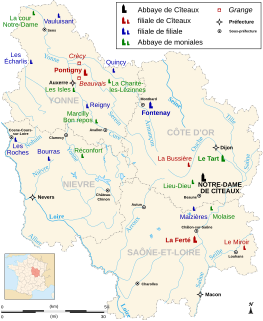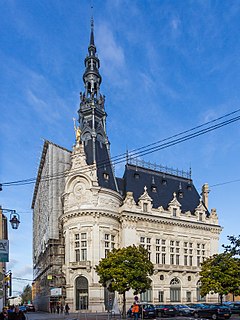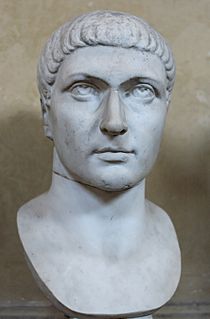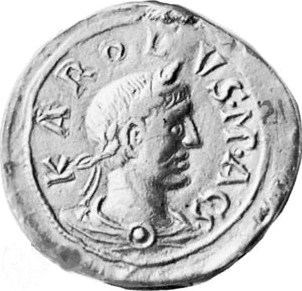
The Roman Catholic Diocese of Autun (–Chalon-sur-Saône–Mâcon–Cluny), more simply known as the Diocese of Autun, is a diocese of the Latin Rite of the Roman Catholic Church in France. The diocese comprises the entire Department of Saone et Loire, in the Region of Bourgogne.

Lièpvre is a commune in the Haut-Rhin department in Grand Est in north-eastern France. A monastery was built here in the eighth century by Saint Fulrad, who filled it with relics of Saint Cucuphas and Saint Alexander.
Saint Syagrius was a bishop of Autun. His feast day is August 27.

The Roman Catholic Archdiocese of Dijon is a diocese of the Latin Rite of the Roman Catholic Church in France. The archepiscopal see is Dijon Cathedral, which is located in the city of Dijon. The diocese comprises the entire department of Côte-d'Or, in the Region of Bourgogne. Originally established as the Diocese of Dijon in 1731, and suffragan to the Archdiocese of Lyon, the diocese was elevated to the rank of archdiocese in 2002. The most significant jurisdiction change occurred after the Concordat of 1801, when the diocese annexed the department of Haute-Marne. In 1821, a Papal Bull re-established the Diocese of Langres. The current archbishop is Roland Minnerath, appointed in 2004.

The former French Catholic diocese of Chalon-sur-Saône existed until the French Revolution. After the Concordat of 1801, it was suppressed, and its territory went to the diocese of Autun. Its see was Chalon Cathedral.

Saint-Privé is a commune in the Yonne department in Bourgogne-Franche-Comté in north-central France.

Toury-Lurcy is a commune in the Nièvre department in central France.
Renier of St Laurent was a twelfth-century Benedictine monk of St Laurent Abbey, Liège. He is known as a writer of theological and exegetical works, controversial and historical works, and numerous biographical and hagiographical works. Works by him are in Patrologia Latina and Monumenta Germaniae Historica.

Tart Abbey, also Le Tart Abbey, was the first nunnery of the Cistercian movement. It was located in the present commune of Tart-l'Abbaye in Burgundy (Côte-d'Or), near Genlis, on the banks of the River Ouche and only a few miles away from Cîteaux Abbey, the Cistercian mother house. The community moved to Dijon in 1623, and the abbey buildings in Tart were destroyed by war shortly afterwards; only ruins remain.

The Fort Saint-André is a medieval fortress in the commune of Villeneuve-lès-Avignon in the Gard département of France, dating from the first half of the 14th century.

The Abbey of Saint-Savin-en-Lavedan was a Benedictine abbey in the commune of Saint-Savin, Hautes-Pyrénées, France. It was one of the most important religious centres in the County of Bigorre. The Romanesque abbey church remains, in use since 1790 as a parish church. It has been listed since 1840 as a monument historique by the French Ministry of Culture.
Émilien of Nantes was a French religious leader who was canonized by the church as a martyr for dying in a fight against the Saracens in Burgundy in 725 AD. No written records earlier than the 16th century survive, and there are no records of a Bishop Émilien of Nantes. The legend probably has its roots in a real clash with the Saracens, who were present in the region at the time, but has been considerably embroidered.

Noël Bouton, Marquis de Chamilly was a French military commander of the 17th and 18th centuries. He was named a Marshal of France in 1703.
Claude Rolley was a French archaeologist, emeritus at the University of Burgundy, writer on art, archaeology of Greece and Gaule.

Louis Schlaefli is a Franco-Swiss scholar, collector, and librarian. Since 1964 he has been the librarian of the Great Seminar of Strasbourg library for which he composed several major catalogs. He is also the author of more than five hundred articles and contributions related to the heritage and history of Alsace, mostly religious ones.
Claude Courtépée was a French priest, teacher and historian. He is known for his comprehensive geographical and historical study of the Province of Burgundy based on his personal observations and deep research, which is still used as a work of reference.

The Abbey of St. Martin is a former Benedictine monastery in Autun, Saône-et-Loire, France, to the northeast of the city just outside the city walls, on the right bank of the Arroux and to the north of the Roman road from Autun to Langres, Beaune and Besançon.
Jean VI Rolin or Rollin, often referred to as Jean II Rolin to differentiate him from his father Jean Rolin or Rollin in the succession of the offices of Bishop of Autun, abbot of the Abbey of St. Martin, Autun, and prior of the Abbey of Saint-Marcel-lès-Chalon, was a French bishop.

Cadouin Abbey was a Cistercian monastery founded as a hermitage in 1115 by Gerald of Salles, in the name of Robert of Arbrissel, in what is now the commune of Le Buisson-de-Cadouin in the Dordogne, south-west France.




















